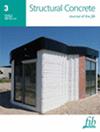Strut‐and‐tie model for column‐to‐drilled shaft connections in reinforced concrete bridge columns subjected to lateral loads
IF 3.3
3区 工程技术
Q2 CONSTRUCTION & BUILDING TECHNOLOGY
引用次数: 0
Abstract
Drilled shafts with a larger diameter than columns are frequently adopted as the foundation of highway bridge columns due to their superior economic efficiency and lower impact on existing facilities in the urban built‐up area. Different section dimensions lead to a socket connection between the column and the oversized shaft and a noncontact lap splice of their longitudinal bars. The force‐transfer mechanism and failure process of column‐to‐drilled shaft connections were deeply revealed in this study. Detailed FE models were developed at the承受横向荷载的钢筋混凝土桥柱中柱与钻孔轴连接的支撑和拉杆模型
由于钻孔竖井具有较高的经济效益,且对城市建成区现有设施的影响较小,因此经常采用直径大于立柱的钻孔竖井作为公路桥梁立柱的基础。不同的截面尺寸导致立柱与超大轴之间采用套筒连接,其纵向杆件采用非接触式搭接。本研究深入揭示了柱与钻孔轴连接的传力机制和失效过程。在 Diana 平台上开发了详细的 FE 模型,并根据之前的实验结果进行了验证。随后,参数研究调查了剪切跨深比、轴柱直径比、柱嵌入深度和轴箍筋比的影响。最后,提出了一种改进的支柱-系杆模型(STM),以有效地设计过渡区域的箍筋,同时考虑到实验失效机理。结果表明,在 Diana 平台上建立的数值模型可以精确模拟柱对钻孔轴连接的力学行为。柱-钻孔轴连接的失效机理是轴箍筋在受压侧屈服,由预埋柱和轴之间的挤压引起。柱-钻孔轴连接的横向承载能力随着剪切跨度-深度比、轴-柱直径比、柱嵌入深度和轴箍筋比的增加而增加。修改后的 STM 能够揭示轴横向配筋需求随各种设计参数的变化趋势,并得出平均箍筋应力比为 1.20,变异系数仅为 8.31%。
本文章由计算机程序翻译,如有差异,请以英文原文为准。
求助全文
约1分钟内获得全文
求助全文
来源期刊

Structural Concrete
CONSTRUCTION & BUILDING TECHNOLOGY-ENGINEERING, CIVIL
CiteScore
5.60
自引率
15.60%
发文量
284
审稿时长
3 months
期刊介绍:
Structural Concrete, the official journal of the fib, provides conceptual and procedural guidance in the field of concrete construction, and features peer-reviewed papers, keynote research and industry news covering all aspects of the design, construction, performance in service and demolition of concrete structures.
Main topics:
design, construction, performance in service, conservation (assessment, maintenance, strengthening) and demolition of concrete structures
research about the behaviour of concrete structures
development of design methods
fib Model Code
sustainability of concrete structures.
 求助内容:
求助内容: 应助结果提醒方式:
应助结果提醒方式:


